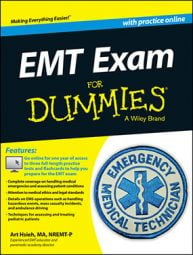The practice questions you see here are similar to the EMT exam’s questions about pediatrics. Read each question carefully, and then select the answer choice that most correctly answers the question.
Sample questions
A 6-year-old female presents sitting upright, with difficulty breathing. Her pulse rate is 100, and she is breathing 22 times per minute. Her skin feels hot, she is pale, and there is audible stridor. You should
(A)position her supine and assist ventilations with a bag-valve mask and oxygen.
(B)provide supplemental oxygen via the blow-by method.
(C)assist ventilations with a bag-valve mask.
(D)inspect her mouth using a tongue depressor.
A 7-year-old male is having difficulty breathing after playing in the schoolyard. He is alert, frightened, breathing 24 times per minute, and has a pulse rate of 130. You note wheezing in both lung fields. His skin feels warm and diaphoretic. You should
(A)help with the administration of the patient’s prescribed multidose inhaler.
(B)help with the patient’s prescribed epinephrine autoinjector.
(C)assist the patient’s breathing with a bag-valve mask.
(D)transport immediately and notify the parents en route.
A 14-month-old male is having breathing difficulty. He cries loudly when you examine him. His skin is pale and dry. His heart rate is 128, and he is breathing at a rate of 30 times per minute. You should
(A)assist ventilations with a bag-valve mask.
(B)separate the child from his parent.
(C)have the parent administer supplemental oxygen using the blow-by technique.
(D)administer high-flow oxygen via a nonrebreather mask.
A 20-month-old child does not respond to your presence. She is breathing 12 times per minute, and her pulse rate is 60. She has been having difficulty breathing during the past 12 hours. You should
(A)assist ventilations with a bag-valve mask.
(B)have the parent administer supplemental oxygen using the blow-by technique.
(C)place her in a sitting position and open her airway.
(D)administer high-flow oxygen via a nonrebreather mask.
A 7-month-old female is lethargic and cries when stimulated. She has had a fever, diarrhea, and little to eat or drink in the last 12 hours. Her heart rate is 150, and she is breathing 50 times per minute. You suspect
(A)respiratory distress.
(B)respiratory failure.
(C)compensated shock.
(D)decompensated shock.
A 14-year-old male collapsed after playing soccer for a few minutes. He is unresponsive and breathing 40 times per minute. His pulse rate is 220, and is felt at the carotid artery only. His skin is cool and diaphoretic. You suspect
(A)sudden dehydration.
(B)severe hypoglycemia.
(C)a cardiac rhythm disturbance.
(D)an asthma attack.
You evaluate a 5-year-old female at a day-care center. The child has had numerous episodes of “staring into space” over the past 2 hours, lasting a few seconds, followed by confusion and being frightened. Her vital signs are normal. Staff is unable to reach the parent. You should
(A)let the child stay at the center until a parent picks her up.
(B)transport to a hospital while attempting to reach the parent.
(C)administer oral glucose.
(D)wait until the parent is notified.
A 4-month-old infant is face up in his crib, pulseless and apneic. There appears to be dark bruising along his back and buttocks. The infant is cold to the touch, cyanotic, and stiff. You should
(A)begin chest compressions and ventilations.
(B)do nothing and transport the infant to the hospital.
(C)provide emotional support for the family.
(D)bring the infant into the ambulance and call police.
A 4-year-old female is nauseous, vomiting, and has diarrhea lasting 40 minutes. Her last oral intake was lunch an hour earlier. She has cramping and pain across her abdomen. She is warm and dry to the touch. Which of the following is the most likely cause of her presentation?
(A)Appendicitis
(B)Cholecystitis
(C)Food poisoning
(D)Peritonitis
A child falls off his bicycle at a high rate of speed. He has road rash on his hands, knees, and the left side of his body; a contusion on the left parietal portion of his head; and a deformity to his left shoulder. He is unresponsive and breathing 6 times per minute. His pulse rate is 76. What should you do first?
(A)Splint the injured shoulder.
(B)Assist ventilations with a bag-valve mask at a rate of 20 per minute.
(C)Immobilize the patient to a long backboard.
(D)Provide high-flow oxygen via a nonrebreather mask.
Answers and explanations
B. The scenario suggests epiglottitis, which causes swelling of the soft tissues in the upper airway.
A. The scenario suggests an asthma attack, which may be resolved with the use of the inhaler.
C. The scenario suggests that the patient is in respiratory distress, not failure.
A. The scenario suggests that the patient is in respiratory failure. The slow pulse rate is an ominous sign of impending cardiac arrest. Assisting ventilations, Choice (A), is imperative; supplemental oxygen.
C. She appears to be dehydrated, although her pulse and breathing rate are just beyond the normal limits.
C. The patient’s heart rate is much too fast, and the onset too sudden, for dehydration, Choice (A), to be the cause. His loss of consciousness, along with signs of decompensated shock, make Choices (B) and (D) very unlikely.
B. The scenario suggests a series of generalized absence seizures — no motor activities, but the patient loses consciousness briefly.
C. The infant shows clinical signs of death.
C. Patients with appendicitis, Choice (A), tend to complain about pain around the belly button or in the right lower quadrant. Cholecystitis, Choice (B), is more located in the right upper quadrant. Peritonitis, Choice (D), comes on relatively slowly.
B. The injury to the patient’s head along with the slower heart and breathing rates suggest increased cranial pressure after a blow to the head.

